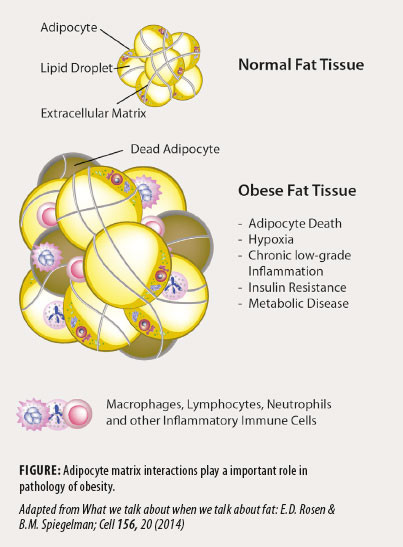This article focuses on the differences between white, brown and beige adipose tissue, as well as the role of adipokines in the development of obesity and insulin resistance.
White, Brown & Brite/Beige Adipose Tissue
During obesity, excess fat accumulates in adipose tissue leading to low-grade chronic inflammation. Obesity is a major risk factor for many metabolic diseases, especially diabetes and cardiovascular diseases, increasing the risk of hypertension, hyperglycemia and dyslipidemia, recognized as the metabolic syndrome. Obesity is also linked to a broad spectrum of pathological disorders including neurodegenerative diseases, airway disorders and cancer.
Two major types of adipose tissue exist in mammals, named white (WAT) and brown adipose tissue (BAT) composed mainly of white or brown adipocytes, respectively. White adipose tissue (WAT) is found throughout the body, primarily under the skin as well as in larger deposits in the abdomen(visceral fat). WAT represents as much as 20-25% of the body weight in humans. White adipocytes are cells of large diameter that consist of one massive lipid droplet and a thin rim containing the cytoplasm and the nucleus. White adipocytes act as storage cells for neutral triacylglycerols, storing excess calories for use in times of scarcity. WAT contributes to whole body insulation and actively communicates with key organs to maintain metabolic homeostasis by secreting adipokines.
Brown adipose tissue (BAT) was only found in hibernating animals and to some extent in human at infancy in the past. Recently, BAT was shown to exist in human adults around the neck and collarbone, similar to where brown fat is found in mice. Brown adipocytes are usually of smaller diameter and composed of several small lipid droplets. Their cytoplasm contains a high amount of mitochondria that are functionalized by uncoupling protein 1 (UCP1). BAT dissipates stored chemical energy in the form of heat and protects against obesity. Recently WAT was found containing cells with the characteristics of brown adipocytes. These cells were named brite (brownin-white), beige or brown adipocyte-like cells. The beige cells have low basal levels of UCP1 that are highly inducible upon stimulation with cold or other agents, while brown cells have high basal levels of UCP1. In addition, brown and beige cells derive from different cell lineages and express different molecular signatures

Adipokines - Obesity, Insulin Resistance & Cardiovascular Biomarkers
Adipokines are defined generally as biologically active substances produced in white adipose tissue (WAT) that act in an autocrine/paracrine or endocrine fashion and communicate with the brain, heart, vasculature, liver and muscle. Some adipokines are produced exclusively or predominantly by adipose tissue, whereas others may be produced in a variety of different tissues. The diversity of the adipokines is considerable, in terms of both protein structure and function. Adipokines include classical cytokines (e.g. TNF-a, IL-6), chemokines (e.g. MCP-1), proteins of the alternative complement system (e.g. Adipsin), proteins involved in vascular hemostasis (e.g. PAI-1), the regulation of blood pressure (Angiotensinogen), lipid metabolism (e.g. RBP4), glucose homeostasis (e.g. Adiponectin, Leptin, Progranulin, Nampt/Visfatin/PBEF, Resistin, Vaspin, Omentin, Lipocalin-2, Apelin, DPP-4, CTRPs, selected ANGPTLs), angiogenesis (e.g. VEGF, NGF) and lipid mobilization (Zinc-a-2-glycoprotein). Adipokines have either pro-inflammatory or anti-inflammatory activities and exhibit a wide range of functions including the regulation of food intake and body weight homeostasis, insulin sensitivity, cell proliferation and angiogenesis, immunity, inflammation or vascular homeostasis. During obesity, adipokines are dysregulated and create a state of chronic low-grade inflammation responsible for the different obesity-linked pathologies and the onset of insulin resistance. Although brown adipose tissue (BAT) also produces adipokines, the endocrine role of BAT in metabolic diseases is not fully investigated. A growing interest in the potential role of adipokines and myokines as biomarkers of low-grade inflammation and metabolic diseases emerges.









